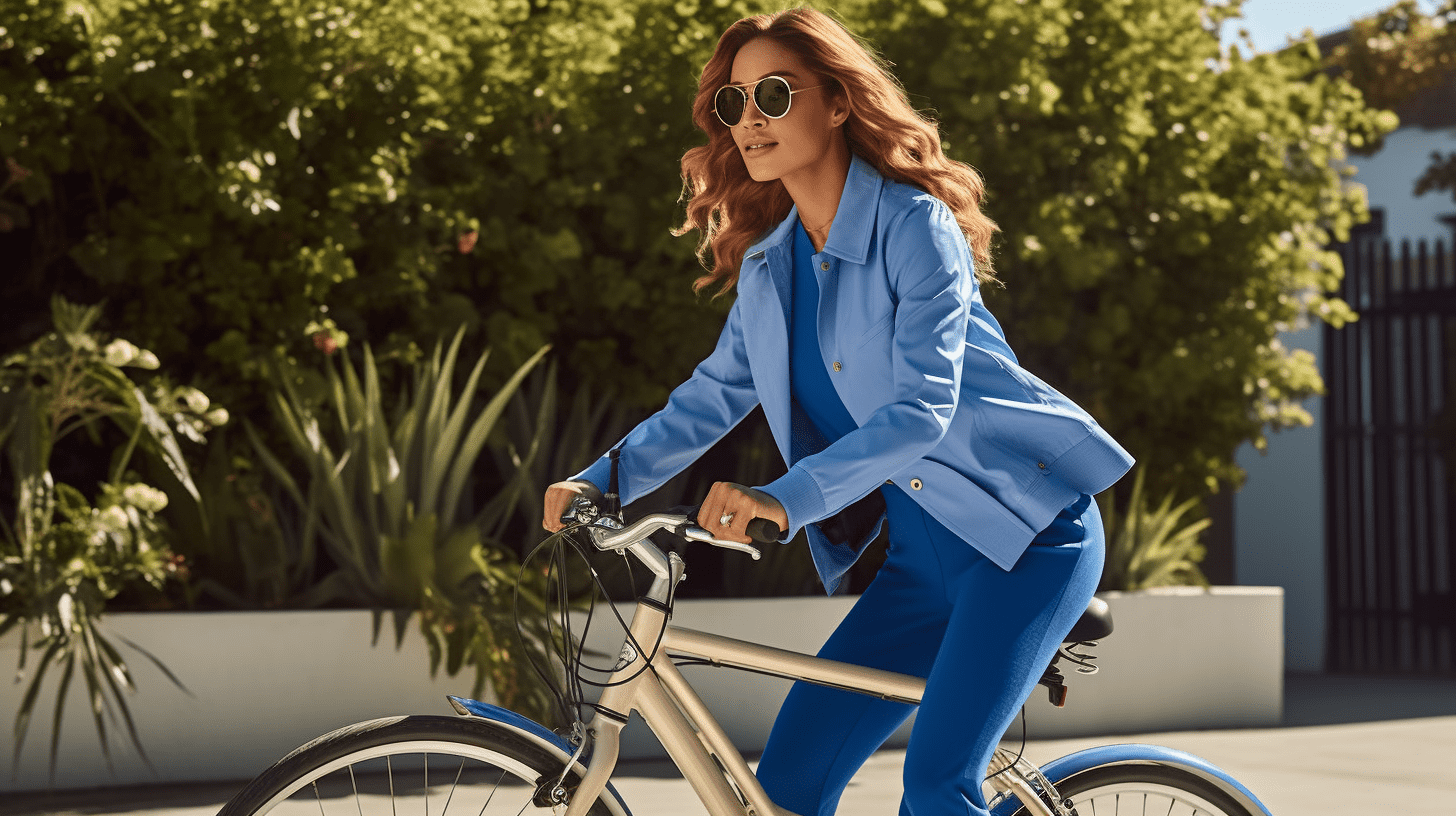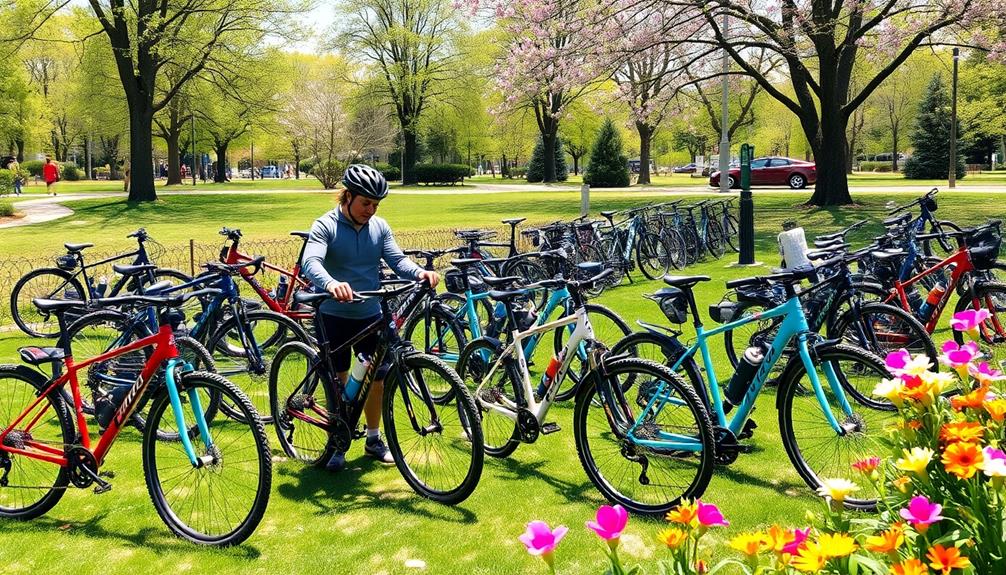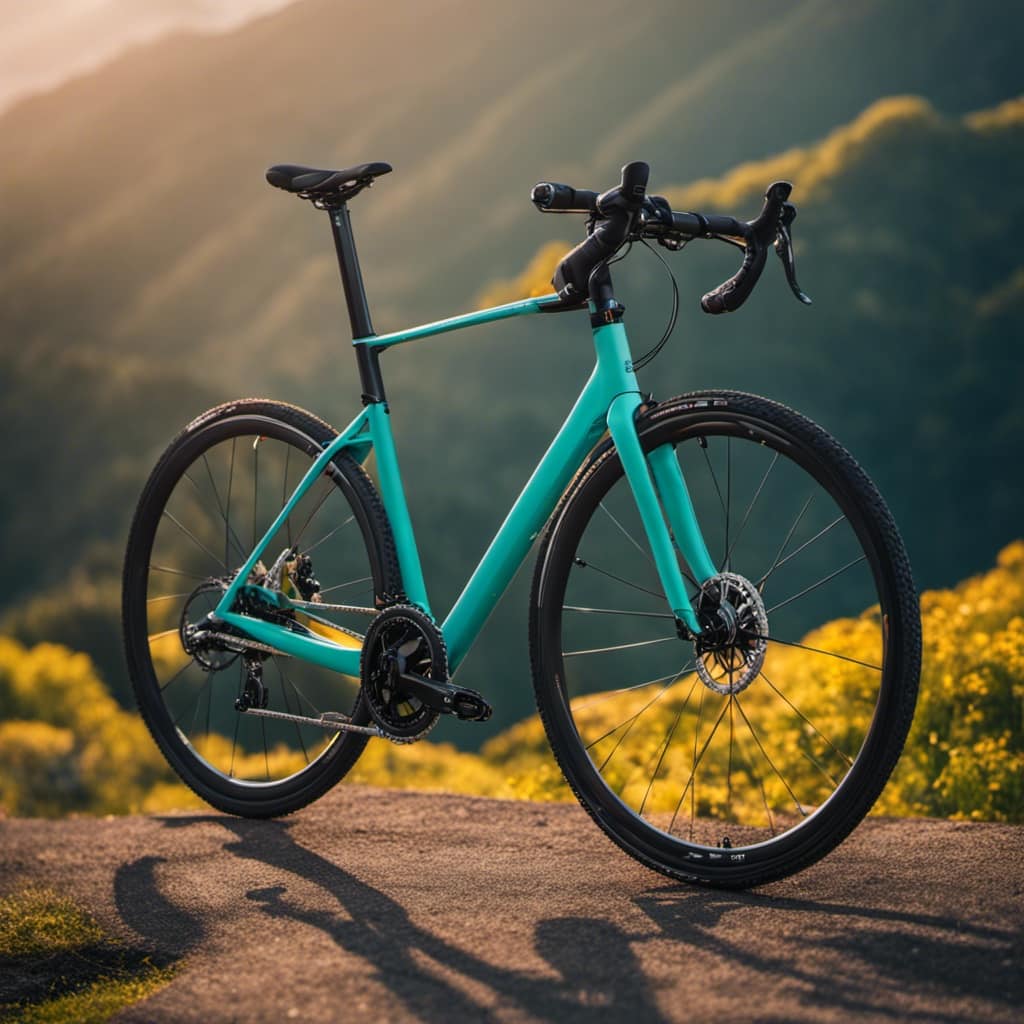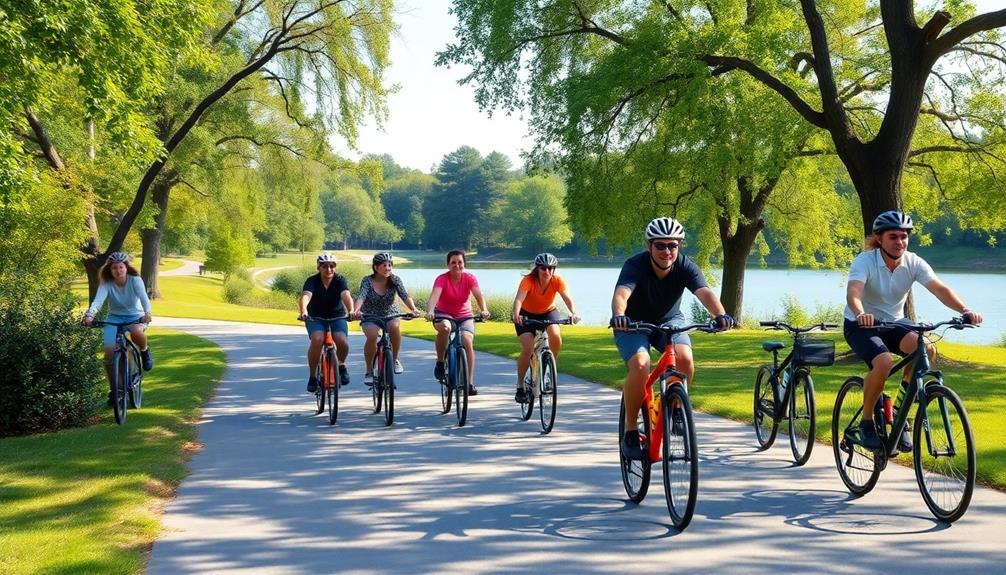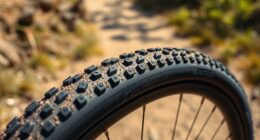Are you searching for an opportunity to soak up some outdoor freshness without getting worn out just a short distance in? If that’s the case, you may want to explore the benefits of hybrid bicycles. These dual-purpose bikes blend ease with velocity, enabling you to cover more ground effortlessly without working up a sweat. Allow me to explain why opting for a hybrid bike means choosing to ride more efficiently rather than exerting more effort.
First and foremost, hybrid bikes are incredibly comfortable. Unlike some other types of bicycles which can leave riders feeling sore after long rides, hybrids feature wider seats and tires which make it easy to keep pedaling mile after mile. Additionally, they have upright handlebars which further increase rider comfort by keeping your back in an ergonomic position while riding. This makes them ideal for pleasure riding or commuting – perfect if you’re looking for an efficient way of getting around town!
Finally, hybrid bicycles are extremely versatile and can handle just about any terrain you throw at them. Whether you’re cruising through city streets or taking on rocky trails, these bikes will take it all in stride! So if you’re looking for an easy way to explore your surroundings without breaking a sweat, then consider taking advantage of the advantages of hybrid bikes today!
Definition Of A Hybrid Bike
Have you ever wondered what a hybrid bike was? A hybrid bike is a type of bicycle that combines many of the features of traditional road bikes, mountain bikes and touring bikes. It’s like an all-in-one package for cyclists who want a versatile and comfortable ride. In this article, we’ll explain what a hybrid bike is and the benefits of having one.
So, what is a hybrid bike? Hybrid bikes typically have flat handlebars like mountain bikes, with wider tires than road bikes so they can be used on different types of terrain. The frames are usually lightweight aluminum or steel to provide extra comfort while riding. They also feature narrow gearing which allows riders to reach higher speeds quickly and easily.
Hybrid bikes are perfect for those who want to get more out of their ride than just speed and power. They’re designed to offer more flexibility in terms of how they can be used, allowing riders to explore different terrains without sacrificing comfort or performance. Plus, with their combination of characteristics from different types of bicycles, hybrid bikes can provide a great experience for any kind of rider regardless of skill level.
Whether you’re looking for an efficient way to get around town or an adventurous way to explore the outdoors, a hybrid bike can give you the freedom you desire without sacrificing safety or convenience. Now let’s look at some of the benefits that come with owning one…
Benefits Of Having A Hybrid Bike
Riding a hybrid bike has its perks, and it’s easy to see why they’re becoming increasingly popular. To put it in a nutshell, owning a hybrid bike allows you to reap the rewards of having an all-in-one package for cyclists who want a versatile and comfortable ride. Here are some of the top benefits of having a hybrid bike:
- Health Benefits: Cycling is great for your health. Not only does it help to strengthen your muscles, but it also increases your cardiovascular fitness and can reduce body fat. This makes cycling one of the most efficient forms of exercise.
- Environmental Benefits: Cycling is more environmentally friendly than driving as it produces no emissions or pollutants. This means that riding a hybrid bike helps to reduce air pollution and contribute towards creating a better world for future generations.
- Economic Benefits: Cycling is also cheaper than driving as there are no fuel costs involved. It can also save you money on car insurance, maintenance costs and parking fees which can add up quickly over time.
- Comfort: Hybrid bikes are designed with comfort in mind, making them perfect for those who want to explore different terrains without sacrificing their own well-being in the process. With wider tires than road bikes and adjustable handlebars, riders can tailor their ride to suit their individual needs – whether they’re looking for an efficient way to get around town or an adventurous way to explore the outdoors.
Overall, owning a hybrid bike provides riders with numerous advantages when compared with other types of bicycles – from improved health and environmental benefits to greater economic savings and comfort during rides.
Types Of Hybrid Bikes
It’s easy to see why hybrid bikes are so popular – they offer a great combination of features from both road and mountain bikes. But when it comes to finding the right one for you, there are several different types of hybrid bikes to choose from. To help you make the best decision, let’s take a look at the four main types of hybrid bikes: commuter hybrids, mountain hybrids, road hybrids and fitness hybrids.
Commuter hybrids are designed specifically for urban riding. They typically have flat handlebars like a mountain bike but also feature wider tires that are more suitable for rides on paved surfaces. The upright riding position makes them comfortable and easy to ride in busy cities or towns.
Mountain hybrids combine features from both mountain and road bikes – they have knobby tires like a mountain bike but also often include disc brakes for better stopping power on dirt trails. They’re ideal for riders who want an all-purpose bike that can handle off-road terrain as well as city streets.
Road hybrids are perfect for those who want a lightweight bike that can go fast on pavement but is also capable on dirt roads or trails. These bikes usually feature drop bars like a traditional road bike but with wider tires and lower gearing than their full-on racing counterparts.
Finally, fitness hybrids are designed for riders who want to get fit while still being able to enjoy some off-road cycling adventures. These bikes usually have flat handlebars and wide tires which provide extra traction on gravel or dirt roads – making them perfect for exploring new places while getting some exercise in along the way.
With so many different types of hybrid bikes available, it can be difficult to decide which one is right for you – especially if you’re new to cycling or don’t know much about the different types of bicycles out there. Let’s explore how to choose the right hybrid bike so you can find your perfect ride!
How To Choose The Right Hybrid Bike
Choosing the right hybrid bike can be a daunting task – after all, there’s so much to consider! But don’t worry, I’m here to help you make the best decision for your riding needs. With a few simple steps, you’ll be able to find the perfect hybrid bike for you and start enjoying the many benefits it has to offer.
First of all, let’s talk about hybrid bike selection. There are many different types of hybrid bikes on the market today, ranging from commuter hybrids to mountain hybrids to road hybrids and fitness hybrids. It’s important to think about what type of riding you plan on doing most often so that you can choose the right type of bike for your needs.
Next up is hybrid bike sizing. Make sure to measure yourself correctly before buying a new bike – this will help ensure that it fits correctly and is comfortable while riding. You should also take into account things like frame size as well as wheel size when considering which hybrid bike would be best for you.
Finally, we need to look at some of the features offered by different models of hybrid bikes. Features like disc brakes, gear shifters and suspension systems can all play an important role in how enjoyable your ride will be – so make sure to consider them when making your selection! And don’t forget about style either – there are plenty of great-looking hybrid bikes out there so make sure you find one that speaks to your personal taste.
So if you’re looking for a versatile bicycle that offers a great combination of features from both road and mountain bikes, then a hybrid bike may just be what you need! From improved comfort and maneuverability to increased speed and agility, these bikes offer a lot of advantages over other types of bicycles – making them an excellent choice for any cyclist looking for freedom on two wheels. So don’t wait any longer – get out there and start exploring with your new ride!
Frequently Asked Questions
What Are The Most Common Brands Of Hybrid Bikes?
Do you want to experience a level of cycling comfort and efficiency that is unparalleled? Do you want the freedom to ride on any terrain without fatigue? If so, then hybrid bikes are for you. These versatile bicycles are a great option for those looking for an efficient and comfortable ride.
When it comes to brands, there is no shortage of choices. Popular companies such as Giant, Specialized, Trek, Cannondale and Scott offer a wide range of hybrid bikes. Each of these manufacturers has their own unique designs and features that make them stand out from the crowd.
Whether you’re looking for an all-purpose bike with increased performance or something more specialized with added features like disc brakes or full suspension, there’s sure to be something from one of these reputable brands that will meet your needs. With so many options available, it’s easier than ever before to find the perfect hybrid bike for your lifestyle and budget.
Hybrid bikes offer riders the best of both worlds – comfort and efficiency – making them a great choice for anyone who wants to take their cycling experience to the next level. With their versatility and dependability, these bikes provide cyclists with the freedom they need to explore any terrain without fear or fatigue. So what are you waiting for? Get out there and get yourself a hybrid bike – your body will thank you!
How Often Should I Maintain My Hybrid Bike?
I’m sure we’ve all heard the saying, “Ride smarter, not harder”. But what does that mean when it comes to hybrid bikes? Well, one of the key advantages of hybrid bikes is that they require less maintenance than other bike types. But how often should I maintain my hybrid bike?
The answer depends on a few things: how often you ride your bike, where you ride it, and what type of terrain you’re riding on. Generally speaking, a good rule of thumb is to inspect your bike once every three months and do basic servicing at least twice a year. It’s also important to check for wear and tear after each ride – this could include checking for loose spokes or bolts or making sure the brakes are working properly. You can also look up specific hybrid bike maintenance schedules online or consult with a professional bike mechanic if you have any questions.
When it comes to servicing your hybrid bike, there are a few basics that need to be done regularly. These include checking and topping off all fluid levels such as oil and brake fluid; replacing items like brake pads, chains and cables; lubricating moving parts; and inspecting tires for signs of wear or damage. Additionally, it’s important to regularly clean your hybrid bike – this will help keep it in top condition for longer.
Regularly maintaining your hybrid bike doesn’t have to be difficult or time consuming – but it can make all the difference in keeping your bike running smoothly and safely for years down the road! Following these basic tips and taking into account factors like where you ride, will help ensure you get the most out of your hybrid biking experience.
Is It Possible To Customize A Hybrid Bike?
Have you ever dreamed of customizing a hybrid bike? Is it even possible? Well, the answer is yes! Hybrid bikes offer great customization options that allow you to create your own unique ride. From custom parts to full-on customization packages, you can customize your hybrid bike however you’d like.
There are many different types of hybrid bike customization options available. You can choose from a variety of custom parts such as frames, wheels, handlebars, and components. There are also complete customization packages which include everything from paint jobs to full overhauls. With all of these options, you can make your hybrid bike truly one-of-a-kind!
Another great thing about customizing your hybrid bike is that it gives you the freedom to express yourself through your ride. You can make it as flashy or as subtle as you want – the possibilities are endless! Not only will it look unique, but it will also be a reflection of your personality and individual style.
So if you’re looking for an exciting way to add a personal touch to your ride, then consider customizing your hybrid bike today! With all the available options and freedom to customize however you’d like, there’s no better way to get out and enjoy the open road with a one-of-a-kind creation that’s uniquely yours.
How Much Does An Average Hybrid Bike Cost?
When it comes to deciding what type of bike to buy, the cost of a hybrid bike might be the first thing that comes to mind. With so many models and styles available, it can be hard to know how much an average hybrid bike costs. Fortunately, this guide will provide insight into the price range of hybrid bikes, helping you determine which option is right for your budget.
The cost of a hybrid bike varies widely depending on the features and components that come with it. Generally speaking, an entry-level hybrid bike will run anywhere from $400-$700 while higher-end models can be priced as high as $2,000 or more. As far as cost comparison goes, some bicycle stores may offer discounts or promotions when buying multiple bikes at once, so keep an eye out for these deals if you’re looking for a good deal.
If you’re willing to invest in a higher quality hybrid bike, you may find yourself with greater performance and reliability in the long run. This could be especially beneficial if you’re someone who uses their bike frequently or plans on utilizing their new ride for more than just casual rides around town. Ultimately, by doing your research and understanding what each different model offers in terms of features and benefits, you’ll have no problem finding the best hybrid bike for your individual needs and budget.
No matter which model you choose, owning a hybrid bike is sure to give you the freedom to explore more places with ease—and all without breaking the bank!
Are Hybrid Bikes Suitable For Long-Distance Riding?
Are hybrid bikes suitable for long-distance riding? Absolutely! They are ideal for those looking to ride longer, further and faster than ever before. Not only do they provide a great level of fitness and comfort, but their unique design also makes them suitable for diverse terrain – from asphalt roads to off-road trails.
Hybrid bikes blend the best features of both road and mountain bikes into one versatile machine. As such, they make a great option for cyclists who want to tackle any kind of terrain on their journey. Hybrid bikes offer a comfortable upright riding position, giving you more control over your bike while also helping to reduce fatigue over long distances. They also have wide tires with a low rolling resistance, which you’ll appreciate when it comes to tackling hills or uneven terrain.
Finally, hybrid bikes can be equipped with features like suspension forks and disc brakes that make them well-suited for off-road trails. This means you can enjoy exploring the countryside without having to worry about getting stuck in mud or navigating tricky terrain. So if you’re looking for an all-in-one option that will help make your rides more enjoyable – no matter how far you go – then a hybrid bike is definitely worth considering!
Conclusion
In conclusion, hybrid bikes are a great option for any cyclist looking to ride smarter, not harder. They are versatile and offer riders the perfect combination of road bike speed and mountain bike comfort. Most brands offer good quality hybrid bikes that range in price from relatively low to quite expensive. It is also possible to customize a hybrid bike to meet your needs and preferences.
For those looking for a long-distance riding experience, hybrid bikes are an ideal choice. A case in point is my friend Tom who has recently taken up cycling seriously and decided to invest in a hybrid bike for his longer rides. He was amazed at how much smoother and more enjoyable the ride was compared to his old mountain bike. The adjustable handlebars, shock absorption system, comfortable saddle and well-designed frame made it easier for him to pedal faster and farther than ever before.
All in all, investing in a quality hybrid bike can be one of the best decisions any serious cyclist can make when it comes to getting the most out of their rides. With the right maintenance schedule, you can enjoy many years of reliable performance while still benefiting from the increased comfort and speed that come with riding a hybrid bike.

